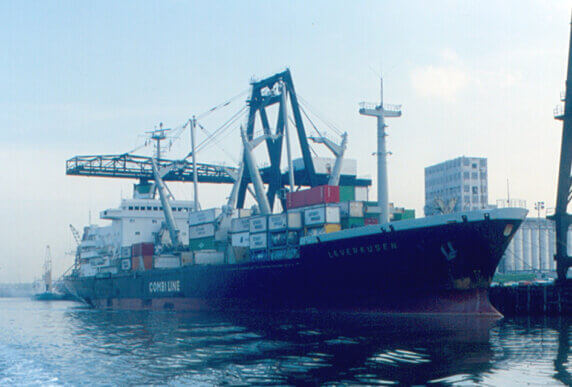Walmart’s Dirty Shipping Problem
On Thursday, March 31, the Society of Environmental Journalists (SEJ) is offering a tour to the Houston Ship Channel, Tour 7, “From the Fenceline to the Frontline: The Battle Against Environmental Racism in Houston’s Ship Channel.” According to the agenda, attendees will tour the Houston Ship Channel, a highly industrialized area of refineries and chemical plants that sit adjacent to predominantly Latino neighborhoods, to better understand the environmental problems faced by fenceline communities. More details here.
In advance of SEJ and this tour, we are providing a backgrounder with Houston shipping facts and some information on how Walmart has contributed to port pollution nationwide and in the Houston area.
Research released by the Ship It Zero coalition, led by environmental advocacy groups Pacific Environment and Stand.earth, in November uncovered that Walmart is the top ocean cargo import polluter to the United States, emitting at least 11,508,463 tons of carbon dioxide from 2018-2020. Walmart’s top port of imports to the United States is Houston, with the company shipping 401,808 twenty-foot equivalent units through the Port of Houston during the same period. CMA-CGM, Walmart’s main shipping partner and the biggest cargo carrier polluter, accounted for nearly 70% of Walmart’s 2020 ocean shipping emissions.
Among the thousands of retailers moving goods into the U.S. via cargo ships, the retail companies in the report are some of the top importers, comprising 7% of the total estimated U.S. imports in 2020, with Walmart and Target in first and second place, respectively. The goods imported to the U.S. between 2018-2020 by these four companies alone accounted for an estimated 20 million metric tons of carbon dioxide equivalent emissions (CO2e), as much as the annual emissions from five coal-fired power plants.
As an emitter of over 3 million metric tons of pollution per year for U.S. ocean imports alone, Walmart has a responsibility to its customers, our port neighbors, and our shared future on Earth to make a commitment to zero emissions ships this decade.
Why It Matters
The campaign is calling on Walmart to end its reliance on fossil-fueled ocean shipping, which is contributing to the warming of our oceans and to the death of coral reefs globally. With at least 14% of the world’s iconic coral reefs having vanished since 2009 according to the United Nations, the time to abandon the dirtiest fuels on the planet and adopt a 100% zero-emissions supply chain has arrived. Texans are lucky to have some of the healthiest remaining coral reefs – but still, the Flower Garden Banks – is predicted to almost disappear by 2050 because of climate change, disease and invasive species. Walmart’s shipping pollution not only puts the health of the oceans and climate at risk, but also the health of port and coastal communities.
Port neighborhoods are struggling with high rates of childhood leukemia. A University of Texas School of Public Health study found that children living within 2 miles of the Ship Channel are 56 percent more likely to develop a type of leukemia than those living 10 miles away. The study also said children living in areas with increased emissions from petrochemical plants were found to have an increased risk of developing any type of leukemia.
Communities of color and working-class communities are hit the hardest by these threats. The Houston Chronicle flagged that families “living along the Houston Ship Channel — where real estate and rents are far more affordable — live with daily assaults on their health. The cancer risk for residents of Manchester and the neighboring community of Harrisburg, where Valero operates a refinery, is 22 percent higher than for the rest of Houston.”
In December of last year, the Houston Chronicle editorialized about the Port of Houston saying, “While the Port of Houston has demonstrated that it is attuned to the challenges of climate change, its leadership has thus far declined to make any ambitious proclamations on reducing emissions and overall pollution, preferring an ad hoc approach that flies under the radar.”
Even the Biden administration has recently sent a strong signal in the direction of zero-emissions shipping. In his State of the Union speech earlier in March, President Biden called for “modernizing…ports” and “promot[ing] environmental justice.” President Biden also referred to the 2020’s as “an infrastructure decade” in his speech. Moreover, at The Economist’s 9th annual World Oceans Summit in March, U.S. Special Presidential Envoy for Climate John Kerry gave a keynote interview in which he explained that fossil-fueled shipping pollution threatens ocean wildlife. In Kerry’s words, “the level of carbon dioxide emissions acidifying the oceans… diminishes the ability of crustaceans to make their shells… We run the risk of tipping points with regard to coral reefs.” To address these problems, the U.S. Special Presidential Envoy for Climate called on American corporations to take rapid responsibility for the health of our oceans: “What is needed above all are corporations to step up and act responsibly,” Kerry said.
Cleaning up our ports isn’t just an environmental issue; it’s a matter of building a healthier America and world. It’s about time that Houston, Walmart, and CMA-CGM act to clean up our ports and protect our neighbors.
Background
Shipping
Approximately 90% of the world trade is transported by sea, and current business-as-usual scenarios project emissions will grow up to 50% over 2018 levels. While the International Maritime Organization noted increased ship size and operational improvements aimed at creating better fuel efficiency have resulted in a decrease in emissions intensity, annual absolute emissions are still increasing.
On its current trajectory, ocean trade is projected to grow by as much as 130% by 2050 over today’s trade volume: if ships remain on fossil fuels, they will represent 17% of global carbon dioxide emissions by mid-century.
The global shipping industry accounts for 3% of global climate emissions, more than global air travel. If shipping were a country, it would be the world’s sixth largest climate polluter. But since maritime shipping negotiated itself out of the U.N. Paris Agreement, the effort to reduce emissions in the industry has been slower than in other sectors.
The science also shows that solutions are within grasp. According to a 2020 International Council on Clean Transportation study, transpacific voyages could be powered by green, carbon and methane-free, electrolyzed hydrogen instead of fossil fuels, with only minor changes to ships’ fuel capacity or operations. Specifically, 57% of journeys could be made by replacing just 5% of ships’ cargo space with more hydrogen fuel or by adding one additional stop to refuel hydrogen en route, while 43% of all voyages could be made without additional fuel capacity or stops.
Retailer Commitments
IKEA and Amazon have signaled initial commitments to reduce their shipping emissions significantly by 2030. IKEA has committed to become “climate positive” by 2030, reducing more greenhouse gas emissions than the value chain emits, including in ocean shipping.
Major shipping companies are making commitments too. Danish shipping giant Maersk announced this year that it will install offshore electric-powered charging stations at up to 100 ports globally to reduce emissions from the approximately 3,500 fossil-fueled ships in its fleet. This will reduce carbon emissions by 5 million tons a year overall.
At COP26, Amazon joined the First Movers Coalition to help commercialize emerging technologies to decarbonize heavy industries including ocean shipping, and committed to moving 10% of its freight on zero-emissions ships by 2030. Also at COP26, governments and CEOs launched the Clydebank Declaration to establish green shipping corridors among some of the busiest maritime shipping routes. And in October, Amazon and IKEA helped launch coZEV, a retailer-led initiative to move 100% of products off of fossil-fueled maritime cargo ships by 2040.
City Commitments
This is something that we are seeing too in the race to zero emissions for ocean shipping – just last month the Ports of Shanghai and Los Angeles announced that they will work with industry to reduce greenhouse gas emissions from the movement of cargo throughout the 2020s, including a goal to “begin” transitioning to zero-carbon fueled ships by 2030 to cut emissions from one of the world’s busiest cargo routes.
Last November, the Los Angeles City Council unanimously voted to adopt Councilmember Nithya Raman’s resolution calling on top ocean cargo importers to the United States, including Walmart, to commit to making all port calls to the San Pedro Port Complex and the Port of Los Angeles 100% zero-emissions ocean shipping by 2030.
About Ship It Zero
Led by environmental advocacy groups Pacific Environment and Stand.earth, the Ship It Zero campaign is calling on some of the world’s largest retailers — including Amazon, Target, IKEA, and Walmart — to transition to 100% zero-emissions cargo shipping vessels by 2030. This goal will ensure the shipping industry does its fair share in helping to keep global warming under 1.5 degrees Celsius, the target scientists say is needed to avoid the worst consequences of the climate crisis.




